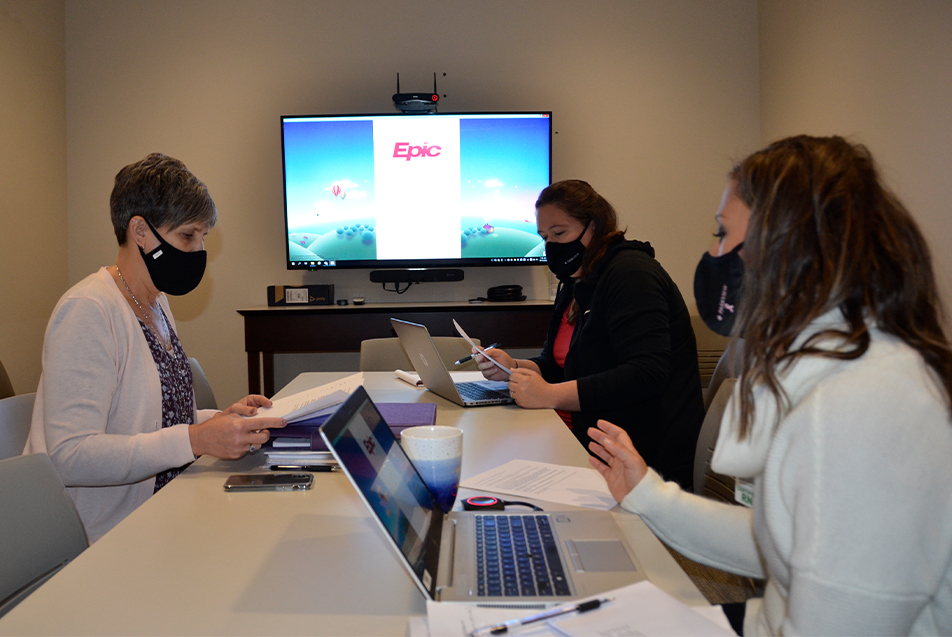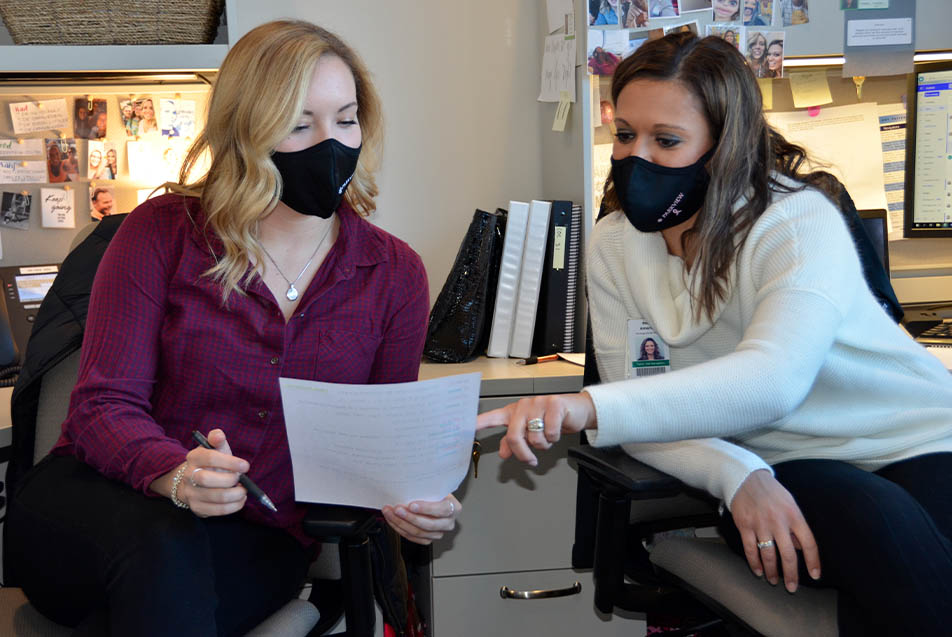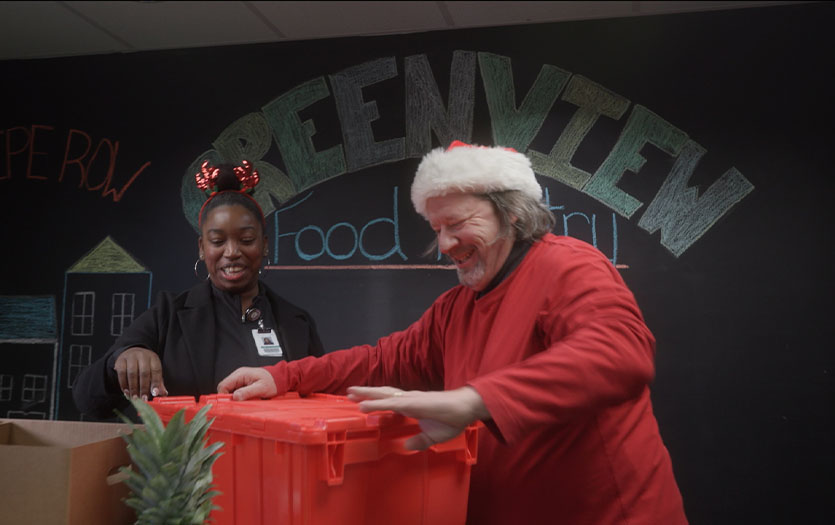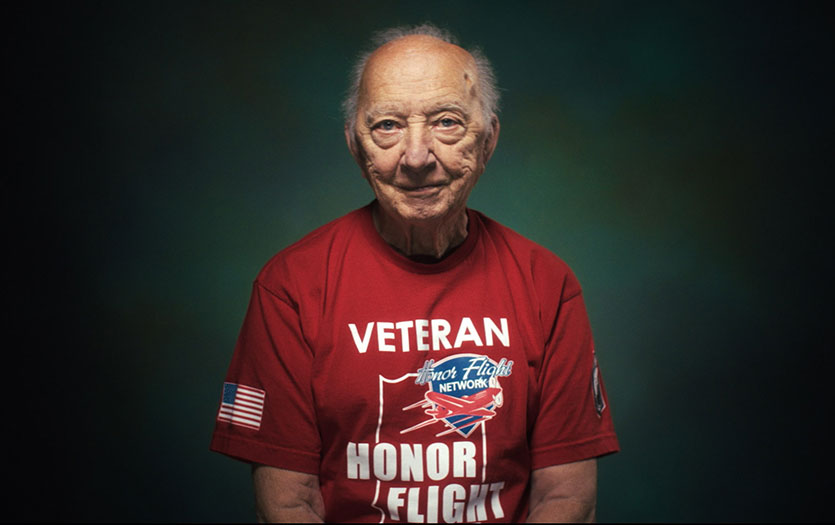
This post was written by Courtney Leach, social media manager, Parkview Health.
When I was little, my sister and I used to love to stay up late playing the board game LIFE. One at a time, we’d spin the plastic white dial and watch the multicolored numbers swirl. Our eager fingers would glide the plastic cars across the rusty orange boxes – Pay Day, Get Married, Buy a House. There was something so satisfying, even as a child, about the uncomplicated act of tucking a little pink or blue plastic person into the back of my vehicle. This, I would think, is what it’s going to be like. Simple. Straightforward.
Now, as an adult with a blue figure next to me and three little pink ones in the back, my perspective has shifted drastically. I’ve seen how things like a significant loss, a global pandemic or an unexpected diagnosis can completely change the board. Drawing one bad card can alter the course forward forever. The economy can crash. Safe bets can be anything but.
For the sake of this article, let’s say a player’s car landed on a pink square labeled “Breast Cancer.” As if out of nowhere, new tiles indicating Pathology, Surgery, Chemotherapy, Radiation, Survivorship and Surveillance would rise from the generic green grass and reroute the path ahead. The game would change, and the player – now the patient – would be understandably disheartened, overwhelmed, confused.
When the Parkview Cancer Institute opened on June 5, 2018, the vision was entirely patient-focused. The providers and leaders wanted to deliver innovative, exceptional treatment options, but they also wanted the overall experience to be different. They wanted to come alongside the patient, from their very first appointment, and hold their hand up until the moment they felt comfortable letting go. The critical piece to this vision was a committed group of caregivers, including a team of navigators, whose primary function would be to provide guidance and minimize ambiguity, which often leads to fear.
I had the privilege of following the handful of navigators dedicated to the Breast Care Team on a clear Tuesday in October. It was a job shadow I’d had on my wish list for years. In fact, back in 2016, at a social gathering the evening before Thanksgiving, a longtime friend of mine, Amanda Turner, RN, told me about a job she was taking at the new cancer institute. Leaning against a wall, various dips and desserts on our plates, she excitedly outlined the details she knew and the potential for where the program might go. “I’ll be with them the whole way,” she said. “My job will be to make sure they always have someone they can call. I could see us adding even more navigators, for different things. It could be even more specialized.” She officially began the role that month, just ahead of the arrival of Ellen Szwed, DO, PPG – Oncology, Breast Care Team, and Linda Han, MD, PPG – Oncology, Breast Care Team, who helped shape the new care model.
So when, after my temperature check, I met her on the fourth floor of the building, I couldn’t help but smile at how full circle the moment felt. Amanda is one of two nurse navigators for the Breast Care Team, the other being Andrea Maggert, BSN, RN. The two actually graduated from nursing school at then-IPFW in 2006 and did their clinicals together. Andrea joined the Breast Care Team in September 2018. The pair oversees a hefty caseload, welcoming approximately a dozen new patients every week while following established patients throughout key touchpoints in their journey.

It was 7:30, and Amanda was busily preparing documents and setting up the screen for a monthly Nursing Committee Action Team (NCAT) meeting. The group works to improve processes and documentation for all of the navigation teams, which currently includes one manager, 11 nurse navigators, six patient navigators, three financial navigators and one chaplain. Charting is a significant piece of the group’s workload. They spend a great deal of time documenting changes in patients’ dispositions, their personal and physical status and any resources provided or recommended. “We use our charting notes, in addition to other documentation we follow, to tell the patient’s story,” Amanda later told me. “Every patient has a story and their story matters.”
On this particular day they were revising a distress tool, used at critical or high-stress touchpoints to assess mental and emotional health. The team takes everything into consideration, including scenarios unique to each cancer site (the part of the body where the cancer started) and caution around the potential to generate distress fatigue, or in other words, the risk of causing distress by asking mental health questions too often. When it comes to treating cancer, nothing is taken lightly and every detail matters.
START
When we left the meeting, my official immersion experience was officially underway. “We need to start at the beginning.” Amanda took me to meet Danielle Barker, RN. Danielle’s office is located just around the corner from Dr. Han’s. Danielle worked with the surgery team for more than seven years before she accepted her newly created role as the nurse navigator specializing in screening and pathology, a position she assumed in December 2019, though she’s been with Parkview since 2013.
Danielle’s job is to support patients at two very pivotal stages of their cancer journey – diagnosis and surveillance. From imaging to biopsy, she makes sure that patients know what to expect every step of the way. “If someone is high risk or they’ve completed treatment, I also help make sure that their surveillance schedule is on track,” she explained. Patients are often surprised by how quickly they can get results. “If someone is high risk or they are returning to see their physician, we will have their results for them that day,” she said. And if someone suspects they have a worrisome lump or receive a referral? “We try to get everyone in for a biopsy within 5-7 days.”

Before a procedure, Danielle makes a first connection, offering to answer any questions the patient might have. On the day of their procedure, she meets and stays with them from start to finish. “It’s helpful for our techs, because then they can focus on their job and what they need to do, knowing the patient is taken care of.” This continues through the next day, when Danielle follows up. “I walk with the patient so that they are never alone.”
Her commitment is a personal one. “My mother was diagnosed with cancer when I was a freshman in high school,” she said. “She was alone when she found out. I don’t want that for anyone. I want them to be comfortable and prepared.” This became more challenging as the PCI team worked to support patients during the height of the COVID-19 pandemic. “They couldn’t bring anyone in with them for some time. I would be with them when they would get news or call their loved one in the parking lot and tell them their spot was suspicious. It was tough. I wanted to be sure they always felt like they had someone with them.”
When it comes time for a patient to move forward to the next phase of care, Danielle can send messages through the patient file portal if she wants the nurse navigators to know something specific or if she feels the patient would benefit from intervention from the patient or financial advocate. Transitions are handled with thoughtfulness and thorough communication, which makes the experience seamless for the patient.
PROCEED TO CARE PLAN
Once a patient has a confirmed diagnosis, Amanda and Andrea receive a referral. Each breast cancer patient is presented to the breast site Tumor Board, which includes all of the key physicians, care and support team members involved with the Breast Care Team, including surgeons, medical oncology and radiation oncology. The group will look at the pathology, patient’s medical history and exam. The nurse navigators are responsible for taking notes regarding recommendations for a care plan at the Tumor Board review and incorporating those into the patient’s Tumor Board letter, which the treating physicians will review and approve before it is considered final.
“Most of our patients receive surgery, and then some receive chemotherapy, then radiation and finally endocrine therapy, though this isn’t always the case,” Amanda said. “At the initial visit the surgeon will typically go ahead and share the care plan with the patient and then we will follow up and verbally present it at their post-op appointment. This gives us a chance to sit down and make sure they can ask any questions that have come up. We can reiterate what the surgeon told them and then open up a conversation.”
The nurse navigators help update and coordinate with all of the providers involved in the treatment plan. “This could be members of the medical oncology team, palliative care, radiation, genetic counseling, their primary care provider, plastic surgery and so on. We make sure everyone knows the plan and who the patient needs to see,” Amanda said.
.jpg)
At their first meeting with new patients, the nurse navigators present them with a sleek black binder. It includes, among other things, a campus map, a calendar for appointments, a tab for organizing lab results, key contacts and general information from trusted sources. Their Tumor Board letter is eventually added and the navigators do their best to three-hole punch all paperwork they receive at subsequent meetings so that it can all be in one place. “We’re always trying to provide resources without overwhelming them,” Amanda said. “It’s a fine line.”
While absolutely everything they do is in the patient’s best interest, the main goal for Amanda and Andrea is education. “After the doctor sees the patient, we often times will come in with the visit summary and go over it with them. This way we can reinforce the information and open the door for them to ask questions. If they don’t have any then, they can always call. If I don’t know the answer, I’m honest about it. I will get it for them and get back to them as soon as I can.” The navigators are connectors. Bridges. They are the one main point of contact and complete instruction manual that helps a patient get from square one to the finish line.
And while something like a binder seems small, it’s not. It’s an invaluable tool and something to help provide some sense of control and order during a time when things largely feel wild and uncontrollable. A lot of the papers and handouts in the binder won’t be utilized immediately, and that’s completely normal. “We recognize that most people have no idea what they’re going to need in the beginning, and that’s totally fine. The important thing for us is that they have resources handy when they do need them.”
GAIN A ROOMMATE
Amanda and Andrea share an office with Sam Bruns, social worker, who has served as the patient navigator for the Breast Care Team since December 2018. Sam’s services are utilized when patients are experiencing emotional distress or might be in need of assistance with practical things, like counseling, food or transportation.
Sam has a bachelor’s degree in social work and, like Danielle, a very intimate connection to her line of work. Her grandmother had breast cancer when she was young and she recently lost her father to pancreatic cancer. In many ways, her current role is a means to honor him and his fight against the disease.

Typically, Amanda or Andrea would see a patient at the first post-diagnostic visit and pull Sam in, as needed, unless it’s already been indicated in a patient’s chart that they might benefit from additional support. For those who qualify based on household income or treatment status, she can offer gas cards provided by either the Parkview Transformative Cancer Care Fund or the Pat Dyer Memorial Fund, as well as food vouchers and community resources from organizations like the Cancer Coalition or Cancer Services of Northeast Indiana to ease a specific strain. “I’m always trying to get additional grants,” Sam said. “Anything we can do by way of funding to improve the experience for our patients and relieve some of the burden they’re feeling.”
The entire navigation team strives to make treatment more convenient. “This isn’t just scary,” Amanda told me. “It’s also a huge disruption to their lives, and that creates a lot of stress.” All patients receive support from the navigation team, dietitian when needed and other PCI-specific services like the wig boutique.
With so many changes happening at once, cancer patients experience a lot of mental distress, including complications related to body dysmorphia, depression, relationship changes and self-esteem. Sometimes the situation can be alleviated to some degree by a small gesture. “I’ve drawn palm trees on a window for a woman who missed her trip to Hawaii because of treatment,” Sam said. “I’ll do pretty much anything to make their situation feel a little lighter.”Finding ways to help those going through such a difficult journey can be taxing, no doubt. “Sure, it’s always difficult, but I truly don’t know what I’m going to do until I’m in the room,” Sam said. “I wait to see where they want to lead the conversation. If they cry, I’ll cry with them. That means that yes, some days you feel just absolutely drained. Self-care is so important. I have to take care of myself so that I am able to give to them.”
Their office is their safe zone. “We’re really good support for each other,” Andrea said. “We are friends outside of work. We know each other well enough to know when someone else needs picked up so they can continue giving.”
“We’re family,” Sam added. “There are days when we have to discuss something that’s bothering us outside of work first so that we can set it aside and be truly focused on the day ahead.” In my time in their space, I listened in as they bounced ideas off of each other, laughed, mourned and shared updates on patients who all of them knew, regardless of who was assigned to the case. They don’t just care when it concerns them. They always care. They’re always invested in the outcome.
The final member of the Breast Care navigator team, and the only one I wasn’t able to meet, is Emily Lawrence, the financial navigator. Emily is available for patients who have insurance or payment questions or concerns. This would include those with a high deductible or who would like to discuss a payment plan. “We’re really lucky that we have a financial navigator available on each floor of PCI,” Amanda said. “I typically scan my list of patients the day before and if they don’t have insurance I make sure Emily knows to check in. I always tell people, ‘We’re all here for you free of charge, so you might as well utilize our team as much as possible!’”
Just as Amanda and I were getting ready to walk out, a provider stopped in for an impromptu brainstorm regarding a patient she had ongoing concerns about. In a moment, all three of their chairs swiveled and the collective energy of the room was focused on one scenario. Sam eventually went in to see her, but the exchange left a strong impression. It was clear that physicians have a great deal of trust in the navigators and consider them to be an extension of their own expertise. The collaboration was a catalyst for a better emotional outcome and certainly increased the scope of what the care team could offer in that particular situation. There were no egos or hierarchy. Just a unified focus on the patient’s best interests and best options.
THE PATIENT WILL SEE YOU NOW
The first patient I saw with Amanda was a woman with stage four breast cancer who was having an extremely difficult day. She was tired and visibly worn. Amanda walked through the visit summary, inserting questions about her occupational status and emotional state. Sam would be coming in to follow up with available resources. They’d explained how they work in tandem, but to see it was different. They were perfect complements; a set of arms wrapping around a woman who needed facts and friendship. She was in a valley and together they were going to see her through it.
As the day went on, Amanda would brief me on the patients between appointments. I never saw her look at her notes before she introduced me to their story. It was clear that she knew these women. She carried their journeys, their nuances, their lives, inside her.
.jpg)
We went in and saw another patient who had just completed the fourth round of a brutal four-cycle treatment called AC, before she would move on to Taxol, which was much easier on the body. “You did it! It’s a big day,” Amanda started. The patient smiled. If there was an opening, an advancement of any kind, to lift the spirit, Amanda knew how to capitalize on it. Throughout my time with the navigators, they all mentioned modest gifts, handwritten notes and small touches they provided to their patients. I guess at the end of the day, we all need a cheerleader, especially when the game gets tough, the score is down and the star player is fighting for the comeback.
“We become so close to these patients,” Sam later told me. “There’s more to our relationships with them than just cancer. There are positive things through the fear and the pain. The coolest part is being able to witness their resiliency. It’s empowering and humbling.”
“And a gift!” Andrea chimed in. “To get to walk with them. It’s an amazing gift.”
The patient who was moving on to Taxol also had a rash, and Amanda was sure to confirm that Dermatology was in the loop. Time and again I saw her connecting, smoothing out a seamless line from providers to patient. “If you have any problems, I want you to let me know. I know who to call,” Amanda assured her. She always ended with, “Is there any other way we could better support you?”
I listened in as patients shared apprehensive thoughts like, “I don’t know how to explain it …” and “I know this sounds crazy …” and “This might be stupid, but …” I realized, just like anything in life, it’s never about one thing. It’s not just about cancer. It’s about the transportation to get to and from treatments, and food insecurity and body changes and the loss of hair and of a sense of self. It’s not as simple as diagnosis and treatment. Over and over Amanda masterfully and patiently unpacked their fears and their setbacks. She made herself available for as long as they needed her.
She met each inquiry and admission with direct eye contact, a gentle nod and a posture that felt personal. She welcomed whatever came in their time together. And perhaps just as important and impressive, she gave the insider scoop. She shared tips she’d picked up from other patients about screening and procedure prep. She provided an informative, but not intimidating, preview of a change in one patient’s treatment plan. “They will ice your hands and feet to prevent neuropathy, but women tell me it’s not that bad. Just remember, you won’t be able to use your hands once you’re settled, so get an audiobook or movie. Something you won’t need to touch.” Again, it seems so small, unless you are the woman receiving the ice treatment. To her, it was huge. So often, anxiety is fed by our own worst vision of what awaits us. Having someone strip away the “what ifs” tames the anticipation with insight and facts.
We went in rooms and we came out of rooms. The navigators made it about so much more than infusions and scans. They collected the pieces that revealed the person behind the patient. They knew about birthday parties and fundraisers. They knew someone had quit smoking and one had gone on vacation. They admired photos and offered recognition for milestones that had perhaps gone unnoted by others.
And for every moment of despair or defeat I saw, I witnessed a dozen more rooted in hope. As one patient said, “You know, the things people are stressed about may not be that bad. You can’t dwell on it or you’ll end up in an early grave. Women need to know their body and know when something’s different. But I am thankful for this day and for every day I get.”
TEAM EFFORT
For a program like this to work effectively, everyone has to be on board. “Our medical oncology, radiation and surgical teams are the best. We are a united front and our patients can tell,” Amanda said. “They don’t have to worry about whether we’re going to do our jobs or not, and we don’t have to worry about what they’re doing. There’s a lot of trust and respect. I can and would go to any of them for anything. We’re all on the same page. We’re here to make things go well for the patient.”
The navigation team will sign off once a patient is established with endocrine therapy or doing well otherwise. At that time, they are turned over to Parkview’s survivorship program, but their nurse navigator is always available. “They’ll never really get rid of me,” Amanda joked. “But survivorship is a great resource to help give them the tools to transition back into their normal life, join a support group, etc.”
Of course there are cases when the outcome is not positive. “When we lose a patient, we have to tell ourselves that we gave them everything we knew to give,” Andrea said. “We made it as light as we could for them.”
“And we know that these patients fight as hard as they can,” Sam added.
FINISH
The last patient we saw was a woman with stage four breast cancer who had just learned she might have to have another procedure to relieve some discomfort she was experiencing after her initial surgery. While Amanda mentioned this patient was a real firecracker, we went in prepared to be met by a heavy heart. Instead, nearly 30 minutes later, Amanda’s original proclamation proved true. I left with a recommendation for the best fishing worms and everything bagels (to be enjoyed separately and in different ways) in town. Sure, we talked about the weight of her surgical options and how she was feeling about them, food resources in town and what else she might need. But more so, she and her husband were excited to catch up with Amanda. They welcomed me into the fold with open arms. If I’d ever doubted the healing power of a positive personal bond, my final impression was perhaps the most brilliant example of connection as medicine.
I thanked the navigators and made my way back to the parking lot. I put the key in my ignition and felt the warmth of one of the year’s last warm days on my forehead through the windshield. I knew the way home. But for possibly the first time ever, I realized how fortunate I was to have the peace, as much as one can, of knowing the immediate path ahead. For those who pulled a card they didn’t see coming, those facing a daunting, unexplored journey, having someone in the passenger seat who knows the shortcuts and the secrets is a prize. It changes the game. It is the best strategy for making it to the finish line – to the sound of that beautiful bell – with a clear plan, peace of mind and perhaps even a new friend.
The navigator program is proving to be exactly what the visionaries who created it always hoped it would be. It is a differentiator. It is what our region was always missing. It’s the thread that stitches together every seam so the patient doesn’t have to. It’s the person-to-person prescription that facilitates healing rather than just treating. Amanda, Andrea, Danielle, Sam and the other navigators are the hand holders on a delicate, precious walk. One which no one should have to take alone.
Life is far from a game, but no matter what cards your dealt, hope is always in play. You just have to surround yourself with people who know what a valuable piece it is.



